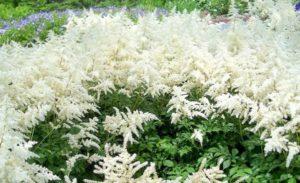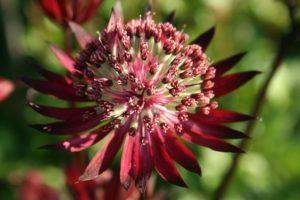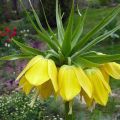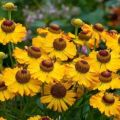Description of the best types of perennial border flowers, design rules
When decorating flower beds, zoning the territory, decorating a garden plot, you cannot do without perennial border flowers. In landscape design, such plants were first used by the Englishwoman Gertrude Jekyll. Flowers, planted once, allow you to maintain harmony on the site for several years, they need minimal care. Among the assortment of perennials, each summer resident will select the best option for his estate.
Registration rules
Most often, stunted flowers are used to create borders. This is due to the fact that the frame of the flower garden, created from living plants, should not obscure the beauty of the flowers inside. For these purposes, they acquire perennials that bloom all summer. Thus, it is possible to create a complete harmonious composition for the entire season on the site.
There are several rules that are followed when making plant borders:
- Flowers are planted around the edges, contrasting with the main range of the front garden.
- Allocate enough space for the border, as the plants will grow over time.
- Do not allow large gaps between the planted plants, it looks sloppy.
- Pick up crops growing quickly and heap.
- Adhere to the size of the border: width - 50 cm, height - no more than 40 cm.
- They opt for unpretentious representatives.
- Borders for beginners should have a simple shape, when the summer resident gains experience in design, you can go to curly ones.
Noteworthy curb perennials
Among the list of popular perennials, there are options for every taste.

Dicenter
This plant is popular for its heart-shaped flowers. A flower is planted from the last days of April. It should be remembered that the dicenter develops well only in illuminated areas, in extreme cases, light partial shade. The soil must be drained, filled with nutrients. If the soil is heavy, river sand is added to it, and a layer of broken brick or pebbles is laid on the bottom. The diameter and depth of the landing pits is 0.4 meters.
Balsam
One of the most unpretentious examples used to decorate borders. Blooms almost all summer. Balsam is usually placed in sunny places, but partial shade is also allowed. The soil should be loamy, it is well filled with rotted manure. It should be noted that this flower is hygrophilous; when the soil dries up in a hot summer, it drops the lower leaves. Balsam has a long flowering - from June to September.At this time, it is covered with white, purple, pink flowers (depending on the variety).
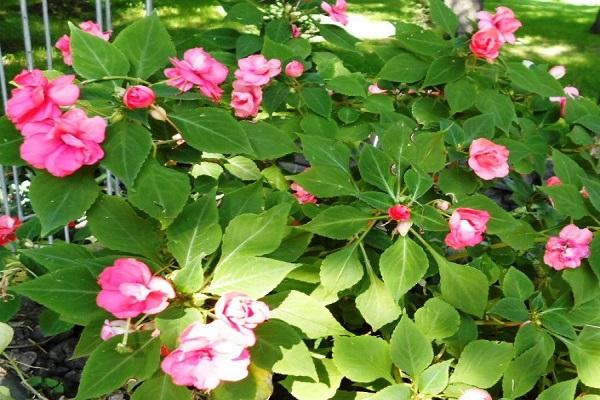
Tenacious
This is a representative of the Lamiaceae family, which fully justifies its name. The plant is really tenacious and does not cause trouble for the owner of the site. During the flowering period, it is covered with buds of white, blue, yellow, purple color. The height of the bushes varies from 5 to 50 cm. When the soil is properly warmed up, the seeds of the tenacious are sown directly into the open ground, they have increased germination. The plant has no special requirements for lighting - it feels comfortable both in the sun and in the shade.
Agapanthus
A characteristic feature of this plant is its beautiful blue flowers. For planting agapanthus, only a well-lit place is suitable, since the plant is photophilous. From early spring to October, the culture needs abundant watering. You will also have to feed the flowers with mineral and organic fertilizers for more lush flowering. A drainage layer is laid at the bottom of the landing pits.

Arabis
This perennial is also called rezuha, belongs to the Cruciferous family. Arabis has creeping shoots, and does not exceed 30 cm in height. Green leaves are heart-shaped, there is dense pubescence on their surface. Razuha blooms with white, pink or light yellow flowers, they are simple or double, depending on the variety.
The best place to create a Arabis curb would be a windy and well-lit area.
Loose soil is prepared, mineral and organic fertilizing is introduced into it. In watering, rezuha needs only strong heat, as it is a drought-resistant plant.
Chrysanthemum
You can also create original borders from low bushes of perennial chrysanthemums. She belongs to the Asteraceae family. To obtain seedlings, seeds are sown in April at home, when the seedlings grow up, they dive into separate containers, and a little later they are transferred to open ground.
It must be remembered that perennial chrysanthemum needs abundant watering and a well-lit area. The soil is preferable loose, with a slightly acidic reaction. As for flowering, you can admire it until the very cold. The color depends on the variety, there are pink, burgundy, yellow, white chrysanthemums.
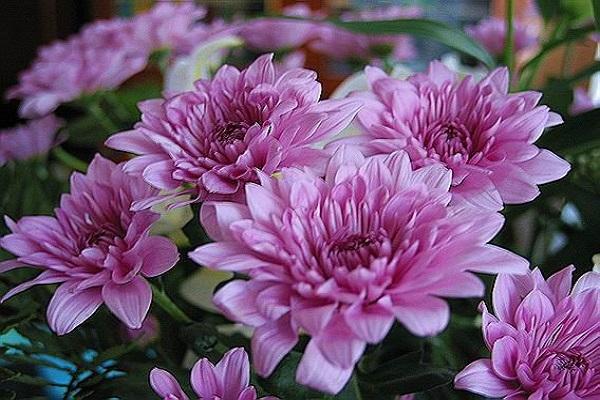
Periwinkle
A perennial herb belongs to the Kutrov family. The ancient Celts called it the witch's flower because they believed it helped to find the witch. A great option for planting in the shade. Even with a lack of light and moisture, it pleases with its bluish flowers. The soil for planting periwinkle is loose, with a neutral reaction. It does not need abundant watering, it endures the winter of cold regions steadily. On the bushes, single flowers can persist until autumn.
Aubrieta, or aubretia
It is a creeping herb. During the flowering period, it forms a spectacular solid carpet. A distinctive feature of the shaving is that the leaves do not fade even in winter. With good care, it gives two waves of flowering - in spring and autumn. Experienced gardeners recommend first growing seedlings at home, and then transferring them to open ground. To admire the spectacular flowering, they select the most illuminated place for it. The soil is loose and moisture-permeable.
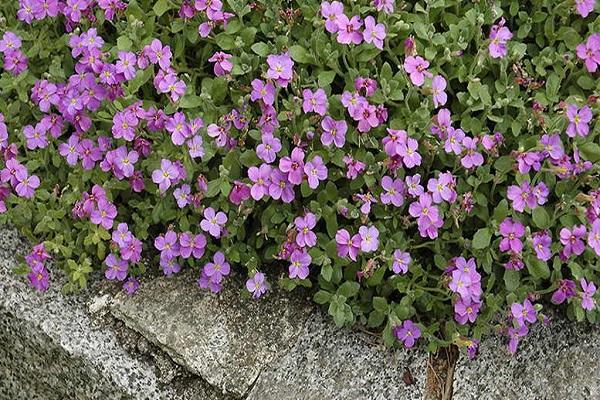
Primrose
The primrose has pinnately dissected leaves of a greenish-gray hue. The shape of the flowers is very diverse - spherical, umbrella-shaped, pyramidal, depending on the selected variety. It is grown through seedlings and then transferred to a flower bed. To do this, prepare light and loose soil in a shaded place.Primrose needs watering no more than once a week; during the entire growing season, fertilizing is applied. It must be remembered that if the primrose is grown from seeds, then it will be possible to admire the first flowering not earlier than in 2-3 years.
Woolly chisel
The herbaceous perennial called "sheep's ears" has amazingly beautiful leaves. They are silvery-gray and soft to the touch. The cleaner does not like places in lowlands where moisture accumulates, but he feels great in open sunny areas. One of the main conditions for successful cultivation is a low nitrogen content in the soil. Watering is infrequent, the plant demonstrates increased resistance to diseases and pests.
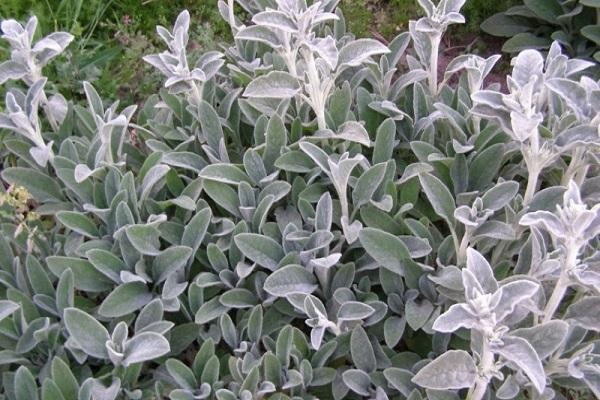
Avens
A representative of the Pink family, with large leaves and flowers of various colors. Growing requires a permeable soil filled with nutrients. The plant belongs to frost-resistant and drought-resistant crops, therefore it does not need special care. He only needs regular watering and weeding.
Sedum
Belongs to the Tolstyankov family. They are grown through seedlings and only then transferred to open ground. It is unpretentious to the ground, it is grown even on rocky, but it will have to be fed with organic matter. It blooms throughout summer and autumn. Stonecrop needs watering only during periods of drought, in other cases there is enough natural precipitation.
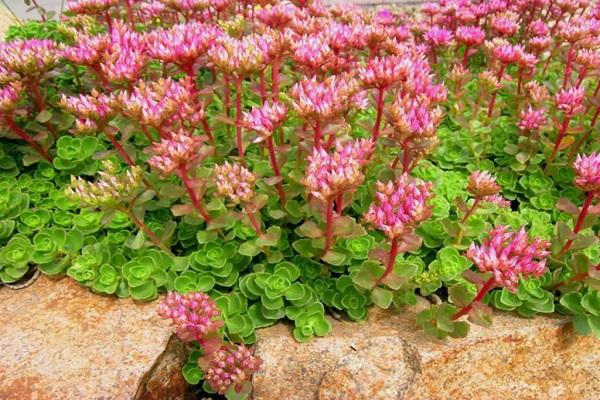
Examples of decorating the border of a garden path with perennial flowers
The following options can be used as ideas:
- Chrysanthemum bushes in contrasting shades.
- Along the edge of the tender daisies, behind them sow thistle
- In the foreground, periwinkle or saxifrage, the second row - primroses, conifers.

A few notes on care
When caring for perennials, they take into account the fact that not all plants are equally in need of moisture, lighting and feeding.
Therefore, only plants with similar care requirements are placed in the same border.
